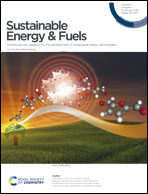Differences in chemical composition and physical properties caused by industrial storage on sugarcane bagasse result in its efficient enzymatic hydrolysis†
Abstract
Sugarcane bagasse (SCB) is a promising feedstock for second-generation ethanol production. Bioconversion of lignocellulose into fermentable sugars involves several technological steps, with biomass pretreatment being among the most expensive ones. Here, we set out to investigate how SCB storage under industrial conditions influences SCB's enzymatic saccharification in the absence of pretreatment. Two sets of SCB samples, fresh (fSCB) and around 6 months aged (aSCB), were collected at relevant industrial settings and compared in terms of their chemical composition, physical structure and efficiency of enzymatic hydrolysis. Chemical and physical analyses revealed significant differences between these samples which had a significant impact on the SCB enzymatic conversion. X-Ray diffraction showed that an average crystallite size is about 20% smaller in aSCB as compared to fSCB. Field emission scanning electron microscopy characterization revealed that fSCB is mainly composed of uniform fibers, while aSCB fibers are more disorganized and unstructured. Confocal laser scanning microscopy images of aSCB demonstrated changes in the autofluorescence spectra, indicating alterations in the lignin structure. Nuclear magnetic resonance relaxometry showed differences in the accessibilities between fresh and aged SCB. Both aSCB and fSCB were hydrolyzed using 25 mg of Cellic® CTec3 per gram of biomass (about 4.1 FPU g−1), and after 96 hours of enzymatic hydrolysis of aSCB without any thermomechanical pretreatment, the yield reached 93% while the fSCB hydrolytic yield was almost 40% smaller. These results can have significant impacts on the optimization of lignocellulosic biomass conversion processes.



 Please wait while we load your content...
Please wait while we load your content...